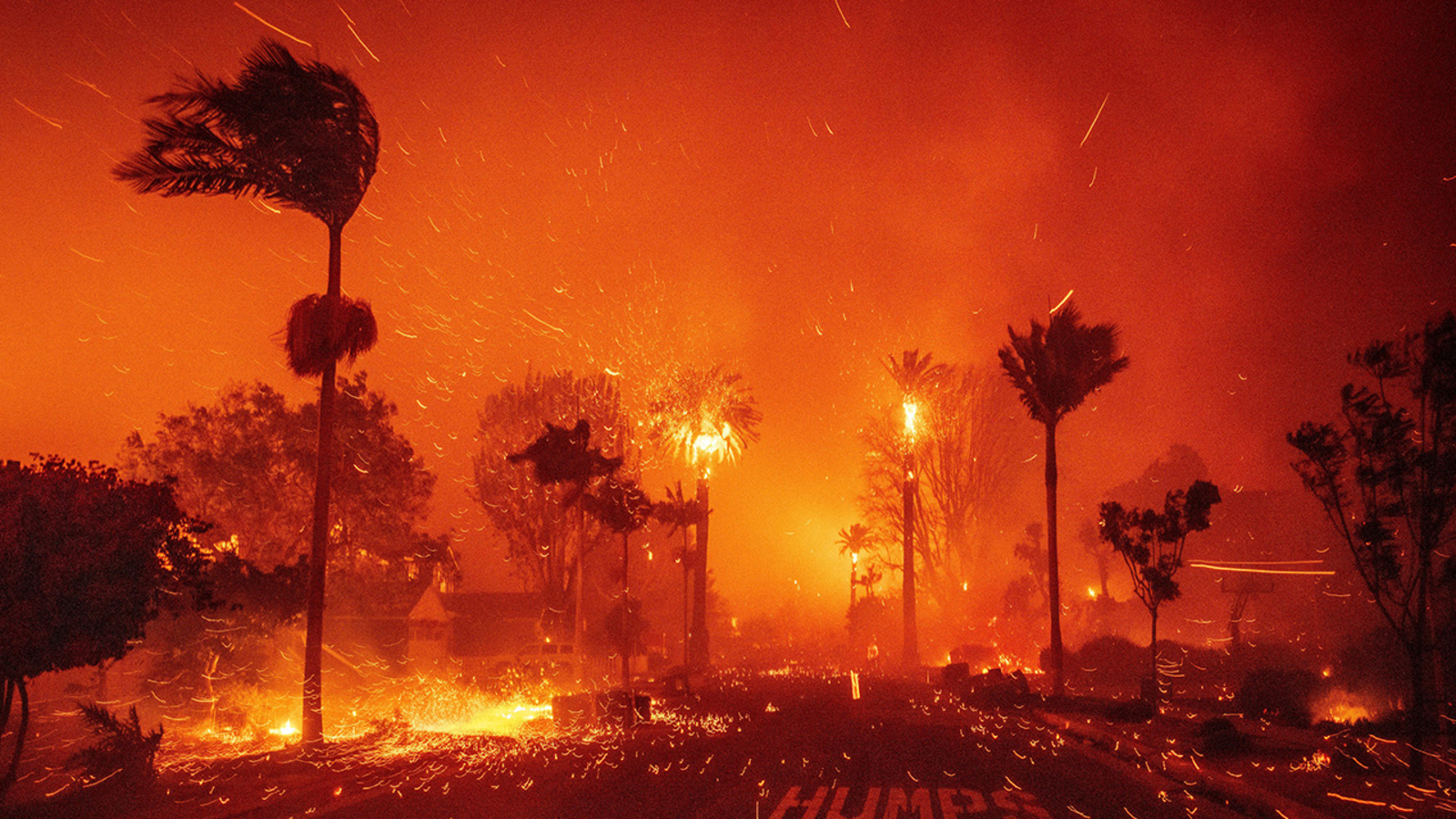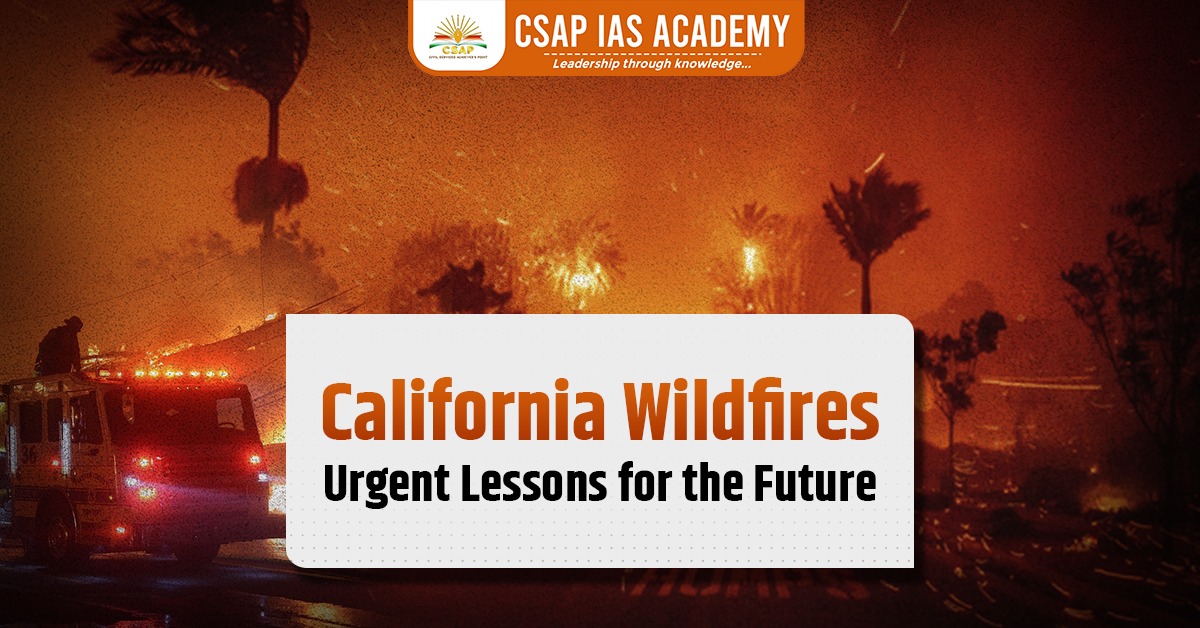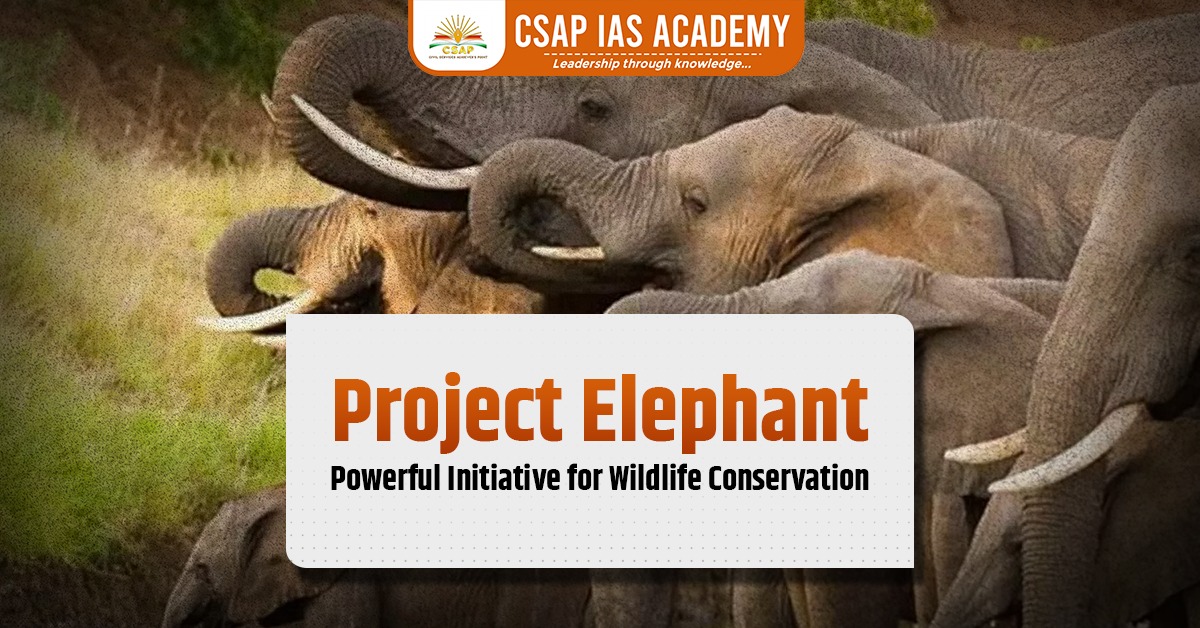California wildfires have become a defining challenge of our time, with their increasing frequency and intensity highlighting the urgent need to address climate change. Driven by rising temperatures, prolonged droughts, and shifting weather patterns, these wildfires pose serious threats to ecosystems, communities, and infrastructure. Understanding their causes and consequences is essential to finding effective solutions.
In this topic, we will discuss the role of climate change in fueling California wildfires, their devastating impacts, and the policy measures required to mitigate and adapt to this growing crisis.
Why is California Wildfires in News?
The recent wildfires in California, particularly in the Los Angeles region, highlight the devastating consequences of climate change on human lives, biodiversity, and socio-economic stability. The fires underscore the urgency of mitigating climate risks through coordinated global efforts.
Key Highlights of the California Wildfires
Environmental Costs
- Biodiversity Loss:
- Forest ecosystems, including rare plants and animals, have been severely impacted.
- Long-term ecological imbalances threaten wildlife habitats and natural biodiversity hotspots.
- Air Pollution:
- Smoke and particulate matter from wildfires degrade air quality, causing severe health hazards like respiratory diseases.
- Increased carbon emissions exacerbate global warming.
Challenges in Fire Management
- Despite having advanced firefighting infrastructure, California struggles to contain the intensity and frequency of wildfires.
- High temperatures, prolonged droughts, and strong Santa Ana winds fuel fire spread and intensity.
Vulnerability of California Wildfires

Climatic Factors
- Prolonged Droughts:
- Persistent dry conditions create a highly flammable environment.
- Water scarcity further hampers firefighting efforts.
- Santa Ana Winds:
- Hot, dry winds accelerate fire spread, making suppression efforts more challenging.
- Rising Temperatures:
- Climate change has raised average temperatures, increasing the likelihood and severity of wildfires.
Geographical Features
- Vegetation:
- Dense forests and dry brush serve as abundant fuel for fires.
- Urban-Wildland Interfaces:
- Proximity of urban settlements to forests increases the exposure of human lives and property to fire hazards.
Anthropogenic Influences
- Deforestation:
- Clearing forests for urban expansion reduces natural barriers to fire spread.
- Power Lines:
- Aging electrical infrastructure often sparks wildfires.
- Overdevelopment:
- Expanding urban areas encroach on natural ecosystems, increasing human vulnerability to wildfires.
Wildfires as Indicators of Climate Change

Part of a Global Phenomenon
- California wildfires represent a broader trend of extreme climate events, including floods, cyclones, and heatwaves, that are intensifying worldwide.
- Such events are driven by rising global temperatures and disrupted natural cycles.
Scientific Evidence of Global Warming
- Temperature Rise:
- The world is already nearing or surpassing the 1.5°C warming threshold set by the Paris Agreement.
- Carbon Feedback Loops:
- Wildfires release large amounts of carbon dioxide, accelerating climate change.
- Loss of forests diminishes natural carbon sinks, exacerbating global warming.
Role of Greenhouse Gases
- Fossil Fuel Combustion:
- Emissions from coal, oil, and gas are primary contributors to climate change.
- Deforestation:
- Forest loss reduces the planet’s ability to absorb CO₂, intensifying the greenhouse effect.
Socio-Economic Implications
Economic Disruption
- Wildfires result in billions of dollars in:
- Property damage and infrastructure loss.
- Rising insurance costs for businesses and individuals.
- Sectors like agriculture and tourism suffer severe economic setbacks due to ecosystem degradation.
Inequality and Vulnerability
- Wildfires disproportionately affect marginalized communities with limited resources to adapt or relocate.
- Vulnerable populations face compounded challenges from displacement and economic instability.
Global Vulnerability
- California’s wildfires are part of a global pattern where different regions face diverse climate-induced disasters:
- Typhoons in Southeast Asia.
- Floods in South Asia.
- Droughts in Africa.
Policy and Political Dimensions

Global Policy Gaps
- Inadequate Global Action:
- International agreements like the Paris Accord have fallen short in achieving emission reduction targets.
- Unequal Responsibility:
- Wealthier nations, which contribute significantly to emissions, have not provided adequate support to vulnerable countries for climate adaptation.
U.S. Policy Landscape
- Federal and state-level initiatives to combat climate change have been inconsistent.
- California leads the U.S. in adopting renewable energy policies but faces challenges in addressing systemic issues like deforestation and infrastructure management.
Scientific Perspective
Predictability of Disasters
- Climate models have long predicted the increasing intensity of wildfires due to rising temperatures.
- Advanced technologies like satellite imagery and AI-driven climate models are improving early warning systems.
Global Scientific Consensus
- The scientific community agrees that human-induced climate change is the primary driver of such extreme events.
- Crossing critical tipping points could result in irreversible ecological and climatic damage.
Way Forward
Global Cooperation
- Stricter Emission Targets:
- Nations must commit to ambitious emission reductions under frameworks like the Paris Agreement.
- Support for Developing Nations:
- Wealthier countries should provide financial and technological aid for climate adaptation.
Policy Reforms
- Renewable Energy Transition:
- Governments must prioritize solar, wind, and other renewable energy sources.
- Sustainable Urban Planning:
- Regulate deforestation and promote climate-resilient infrastructure development.
Community Engagement
- Awareness Campaigns:
- Educate the public on climate risks and encourage individual actions.
- Grassroots Movements:
- Support local initiatives for climate adaptation and disaster preparedness.
Technological Innovations
- AI and Satellite Technologies: For advanced fire detection and early warnings.
- Carbon Capture: To mitigate emissions and offset carbon released by wildfires.
Resilience and Adaptation
- Forest Management:
- Invest in controlled burns, reforestation, and other strategies to reduce fire intensity.
- Climate-Resilient Infrastructure:
- Build infrastructure that can withstand extreme weather events and reduce vulnerabilities.
Conclusion
The California wildfires serve as a stark reminder of the urgent need for global climate action. Addressing the underlying causes, including emissions and deforestation, requires coordinated efforts at all levels—local, national, and international. Failure to act decisively will lead to escalating disasters, with catastrophic consequences for biodiversity, economies, and human lives. Immediate, innovative, and sustained actions are critical to mitigating climate risks and ensuring a sustainable future.
Read: Advantage Assam 2.0
Download App:










